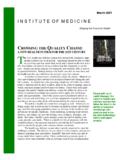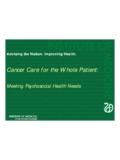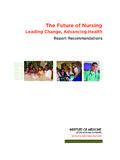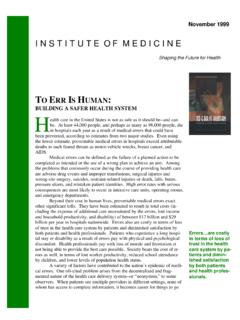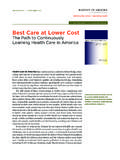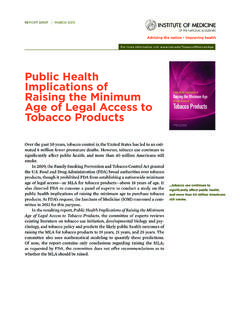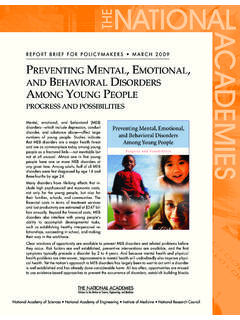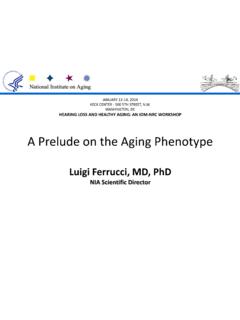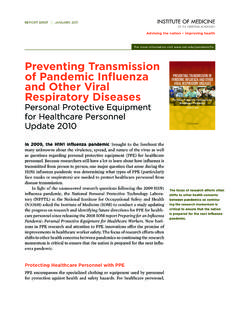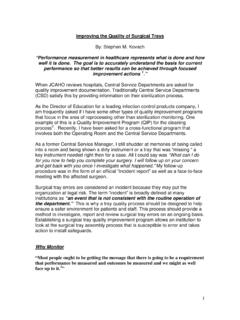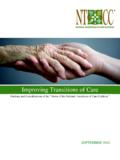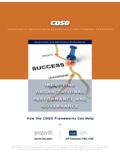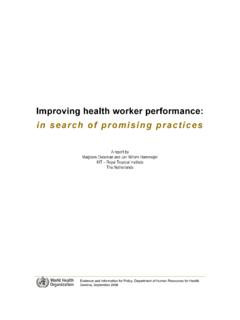Transcription of Dying in America - National-Academies.org
1 For more information visit in America improving quality and Honoring Individual Preferences Near the End of LifeFor patients and their loved ones, no care decisions are more profound than those made near the end of life. For the millions of Americans who work in or with the health care sector including clinicians, clergy, caregivers, and support staff providing high- quality care for people who are nearing the end of life is a matter of professional commitment and responsibility. Health sys-tem managers, payers, and policy makers, likewise, have a responsibility to ensure that end-of-life care is compassionate, affordable, sustainable, and of the best quality possible. A substantial body of evidence shows that broad improvements to end-of-life care are within reach. In Dying in America , a consensus report from the Institute of Medicine (IOM), a committee of experts finds that improving the quality and availability of medical and social services for patients and their families could not only enhance quality of life through the end of life, but may also contribute to a more sustainable care Pressing Need to Improve End-of-Life CareA number of factors make the IOM study particularly timely, including the rapidly increasing number of older Americans with some combination of frailty, physical and cognitive disabilities, chronic illness, and functional limi-tations.
2 The population also is quickly becoming more culturally diverse, heightening the need for responsive, patient-centered care. In addition, the nation s health care system is increasingly burdened by fac-tors that hamper delivery of high- quality care near the end of life, including barriers in access to care that disadvantage certain groups; a mismatch between the services patients and families need and the services they can obtain; improving the quality and availability of medical and social services for patients and their families could not only enhance quality of life through the end of life, but may also contribute to a more sustainable care BRIEF SEPTEMBER 20142 inadequate numbers of palliative care specialists and too little palliative care knowledge among other clinicians who care for individuals with serious advanced illness; and a fragmented care delivery system, spurred by perverse financial incentives, that contributes to the lack of service coordination across programs and unsus-tainable growth in for ImprovementAlthough the systems that support people at the end of life face increasing challenges and strain, there are new and encouraging opportunities for improvement.
3 For example, there is growing knowledge within medical and social care com-munities about how to better engage patients and families in advance care planning and shared decision making, including seriously ill children and adolescents who may be able to participate in their own end-of-life care decisions. Other promising opportunities to improve care include utilization of new communications technolo-gies, growing recognition and support for family caregivers, and the development of quality mea-sures to increase accountability. Finally, accord-ing to the IOM committee, the greatest potential for positive change may lie in health care system reforms that affect the organization and financing of health services. The committee makes recommendations in the areas of care delivery, clinician patient com-munication and advance care planning, profes-sional education and development, payment sys-tems and policies, and public engagement and of Person-Centered, Family-Oriented End-of-Life Care Ideally, health care should harmonize with social, psychological, and spiritual support to achieve the highest possible quality of life for people of all ages with serious illnesses or injuries.
4 Toward this end, the IOM committee recommends that integrated, person-centered, family-oriented, and consistently accessible care near the end of life be provided by health care delivery organizations and covered by government and private health insurers. The committee finds that a palliative approach typically affords patients and families the highest quality of life for the most time possible. For the purposes of the report, the committee defines pal-liative care as that which provides relief from pain and other symptoms, supports quality of life, and is focused on patients with serious advanced illness and their families. Palliative care may begin early in the course of treatment for a serious condition. Hospice is an important approach to addressing the palliative care needs of patients with limited life expectancy and their families. For people with a terminal illness or at high risk of Dying in the near future, hospice is a comprehensive, socially sup-portive, pain-reducing, and comforting alternative to technologically elaborate, medically centered interventions.
5 It therefore has many features in common with palliative care. Although palliative care is well established in most large hospitals and professional educa-tion programs, the committee identifies the need for greater understanding of the role of palliative care by both the public and care professionals as one of the greatest remaining challenges in the delivery of high- quality end-of-life Patient Communication and Advance Care Planning Many people nearing the end of life may not be physically or mentally capable of making their own care decisions. In addition, family members and clinicians may not be able to accurately guess what a person s care preferences may be. There-fore, advance care planning is critically impor-tant to ensure that patients goals and needs are met. Although advance directive documents can be useful, they should allow health care agents and care providers to make informed decisions 3on other clinicians who provide care for individ-uals with serious advanced illness but who may lack training and experience necessary to meet their patients palliative care needs.
6 The commit-tee recommends that educational institutions, professional societies, accrediting organizations, certifying bodies, health care delivery organiza-tions, and medical centers take measures to both increase the number of palliative care specialists and expand the knowledge base for all and Payment Systems to Support High- quality End-of-Life CareSustainable improvements in the organization and financing of end-of-life care must take into account the need to stabilize health care costs over time. The IOM committee finds that reform is needed in how resources for care provided near the end of life are organized. Current financial incentives encourage a reli-ance on acute care settings that often are costly and poorly suited to the needs, goals, and prefer-ences of patients and their families. The commit-tee recommends a major reorientation of payment systems to incentivize the integration of medical and social services, the coordination of care across multiple care settings, and the use of advance care planning and shared decision making to better align the services patients receive with their care goals and preferences.
7 This reorientation will improve access to services that better respond to the needs of patients and their loved ones and may also help stabilize health care committee identifies the need for greater understanding of the role of palliative care by both the public and care professionals as one of the greatest remaining challenges in the delivery of high- quality end-of-life care. in certain circumstances and should not take the place of open, continuous communication. According to the IOM committee, the advance care planning process can begin at any age or state of health and should center on frequent conversations with family members and care providers. Electronic storage of advance direc-tives, statements of wishes, or other relevant materials holds promise for improving access to and effectiveness of these materials. Professional societies and other organizations that establish quality standards should develop standards for clinician patient communication and advance care planning.
8 Payers and health care delivery organizations should adopt these standards as a necessary component of high- quality care for individuals with advanced serious illness and their families and enable them to seek these ser-vices from their physicians and Education and DevelopmentThe education of health professionals who pro-vide care to patients at the end of life has sub-stantially improved in recent decades. Hospice and palliative care is now an established medical specialty, and palliative care has a strong presence in clinical education, professional organizations, and research communities. However, the IOM committee finds that important deficiencies per-sist. First, recent knowledge gains have not neces-sarily translated to improved patient care. Second, the supply of palliative care and hospice special-ists is small, meaning that many patients must rely The Institute of Medicine serves as adviser to the nation to improve health.
9 Established in 1970 under the charter of the National Academy of Sciences, the Institute of Medicine provides independent, objective, evidence-based advice to policy makers, health professionals, the private sector, and the 2014 by the National Academy of Sciences. All rights Fifth Street, NW Washington, DC 20001 TEL FAX on Approaching Death: Addressing Key End-of-Life IssuesPhilip A. Pizzo (Co-Chair) Stanford University, CADavid M. Walker (Co-Chair) Former Comptroller General, Bridgeport, CTPatricia Bomba Excellus BlueCrossBlueShield, Rochester, NY Eduardo Bruera University of Texas MD Anderson Cancer Center, HoustonCharles J. Fahey Fordham University and Milbank Memorial Fund, Syracuse, NY Pamela S. Hinds Children s National Health System and The George Washington University, Washington, DCKarla F. C. Holloway Duke University, Durham, NCNaomi Karp Consumer Financial Protection Bureau, Washington, DCJean S.
10 Kutner University of Colorado School of Medicine and University of Colorado Hospital, AuroraBernard Lo Greenwall Foundation, New York, NY Salimah H. Meghani University of Pennsylvania School of Nursing, PhiladelphiaDiane E. Meier Center to Advance Palliative Care and the Icahn School of Medicine at Mount Sinai, New York, NY William D. Novelli Georgetown University, Washington, DCStephen G. Pauker Tufts University School of Medicine and Tufts Medical Center, Boston, MAJudith R. Peres Chevy Chase, MDLeonard D. Schaeffer University of Southern California, Santa MonicaW. June Simmons Partners in Care Foundation, San Fernando, CAChristian T. Sinclair Gentiva Hospice, Overland Park, KSJoan M. Teno Brown University, Providence, RIFernando Torres-Gil University of California, Los AngelesJames A. Tulsky Duke University Medical Center, Durham, NCAdrienne Stith Butler Senior Program Officer Stephanie H. Pincus Scholar-in-Residence Lauren Shern Associate Program OfficerBradley Eckert Research Associate (through August 2014)Thelma Cox Administrative Assistant Study StaffJudith A.
